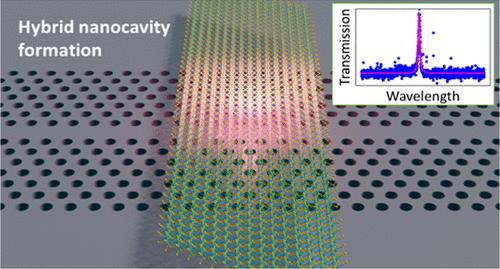当前位置:
X-MOL 学术
›
ACS Photonics
›
论文详情
Our official English website, www.x-mol.net, welcomes your feedback! (Note: you will need to create a separate account there.)
Self-Aligned Hybrid Nanocavities Using Atomically Thin Materials
ACS Photonics ( IF 6.5 ) Pub Date : 2024-05-17 , DOI: 10.1021/acsphotonics.3c01927 Chee Fai Fong 1 , Daiki Yamashita 2, 3 , Nan Fang 1 , Shun Fujii 2, 4 , Yih-Ren Chang 1 , Takashi Taniguchi 5 , Kenji Watanabe 6 , Yuichiro K. Kato 1, 2
ACS Photonics ( IF 6.5 ) Pub Date : 2024-05-17 , DOI: 10.1021/acsphotonics.3c01927 Chee Fai Fong 1 , Daiki Yamashita 2, 3 , Nan Fang 1 , Shun Fujii 2, 4 , Yih-Ren Chang 1 , Takashi Taniguchi 5 , Kenji Watanabe 6 , Yuichiro K. Kato 1, 2
Affiliation

|
Two-dimensional (2D) materials are increasingly being adopted in hybrid photonics via integration with photonic structures, including cavities. The utility of 2D materials for dielectric environment engineering in hybrid nanophotonic devices remains largely unexplored. We demonstrate self-aligned hybrid nanocavities in which 2D material flakes are used to form cavities locally wherever they are placed along the PhC waveguide postfabrication. We successfully fabricated such hybrid nanocavities with various 2D materials on silicon PhC waveguides, obtaining Q factors as high as 4.0 × 105. Remarkably, even monolayer flakes can provide sufficient local refractive index modulation to induce high Q nanocavity formation. We have also observed cavity PL enhancement in a self-aligned MoTe2 cavity device with an enhancement factor of about 15. Our results highlight the prospect of using such 2D material-induced PhC nanocavities to realize a wide range of photonic components for hybrid integrated photonic circuits.
中文翻译:

使用原子薄材料的自对准混合纳米腔
通过与光子结构(包括腔体)集成,二维(2D)材料越来越多地被应用于混合光子学中。二维材料在混合纳米光子器件介电环境工程中的应用在很大程度上尚未得到探索。我们展示了自对准混合纳米腔,其中 2D 材料薄片用于在制造后沿 PhC 波导放置的任何位置局部形成腔。我们成功地在硅 PhC 波导上用各种 2D 材料制造了这种混合纳米腔,获得了高达 4.0 × 10 5 的 Q 因子。值得注意的是,即使是单层薄片也可以提供足够的局部折射率调制以诱导高 Q 纳米腔的形成。我们还在自对准 MoTe 2 腔器件中观察到腔 PL 增强,增强系数约为 15。我们的结果突出了使用这种 2D 材料诱导的 PhC 纳米腔实现广泛范围的前景。用于混合集成光子电路的光子元件。
更新日期:2024-05-17
中文翻译:

使用原子薄材料的自对准混合纳米腔
通过与光子结构(包括腔体)集成,二维(2D)材料越来越多地被应用于混合光子学中。二维材料在混合纳米光子器件介电环境工程中的应用在很大程度上尚未得到探索。我们展示了自对准混合纳米腔,其中 2D 材料薄片用于在制造后沿 PhC 波导放置的任何位置局部形成腔。我们成功地在硅 PhC 波导上用各种 2D 材料制造了这种混合纳米腔,获得了高达 4.0 × 10 5 的 Q 因子。值得注意的是,即使是单层薄片也可以提供足够的局部折射率调制以诱导高 Q 纳米腔的形成。我们还在自对准 MoTe 2 腔器件中观察到腔 PL 增强,增强系数约为 15。我们的结果突出了使用这种 2D 材料诱导的 PhC 纳米腔实现广泛范围的前景。用于混合集成光子电路的光子元件。






































 京公网安备 11010802027423号
京公网安备 11010802027423号